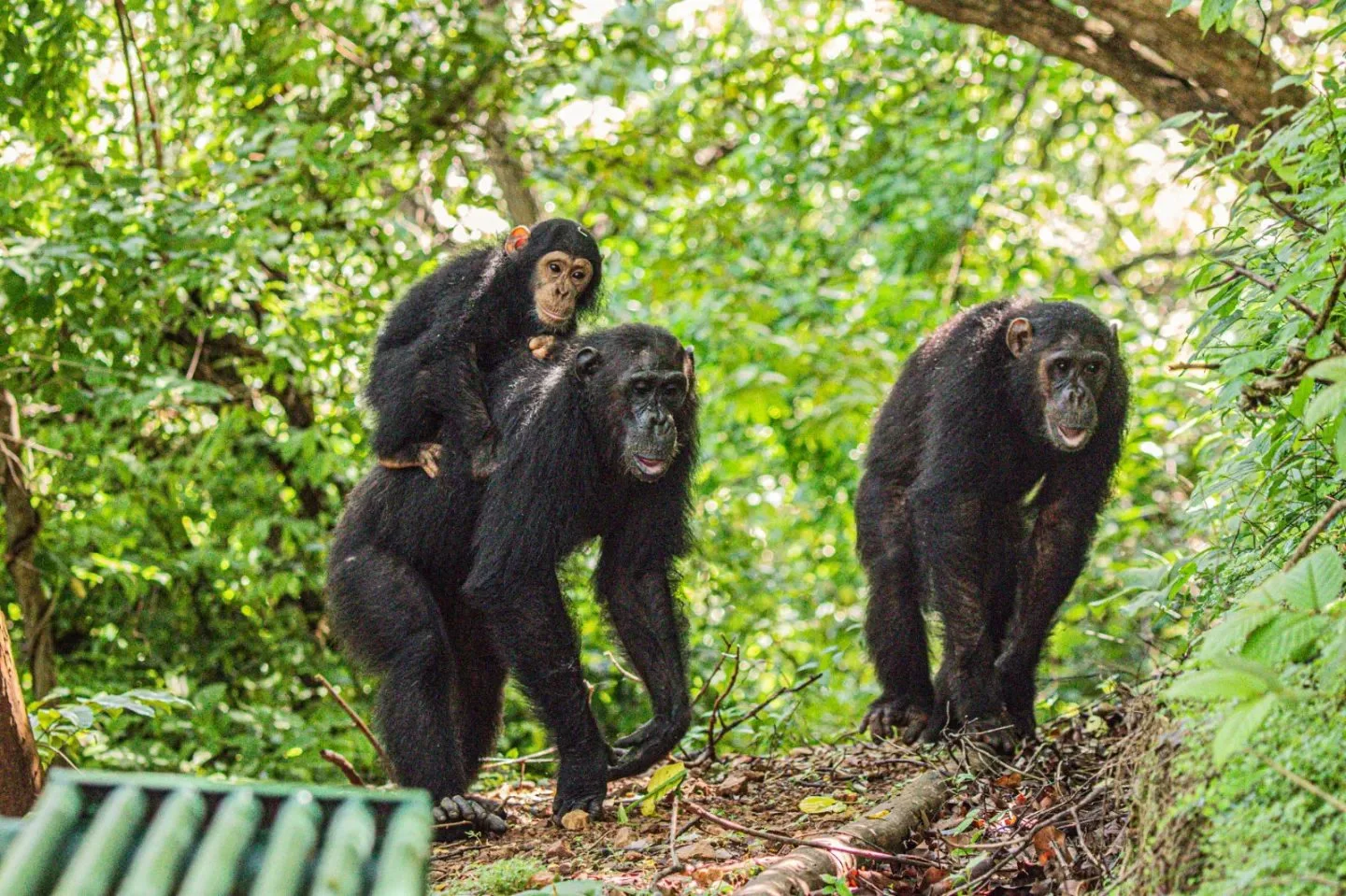Region: Kigoma
Access: By boat
Attractions: Chimpanzees, Lake Tanganyika
Activities: Chimp trekking, swimming
Accommodation: Available within the park
Best time to visit: All year round
Useful link: Gombe National Park - TANAPA
The highlight of Gombe is its chimpanzee community. These chimps, who share over 98 percent of human genes, have been extensively studied and are considered one of the most closely observed populations
Gombe National Park is a narrow forest area, covering 52 sq. km., located in a mountainous region with steep valleys along Lake Tanganyika. The park was initially designated as a game reserve in 1943 for its importance in wildlife and chimpanzee habitat. The main attraction of the park is the protected chimpanzees that reside within it. The park is characterized by numerous steep ridges and valleys, which you will explore on foot to observe the chimpanzees. The scenery in Gombe is breathtaking, with many of the valleys containing flowing streams throughout the year
Within this park, you have the opportunity to encounter the renowned chimpanzee community. These Gombe Chimps, who share over 98 percent of human genes, have been extensively studied and are considered one of the most closely observed populations. It’s like receiving a familiar gaze from our closest animal relatives
The majority of mammals in Gombe National Park are primates, particularly forest-dwelling species. Alongside the famous chimpanzees, you may also spot the vibrant red-tail and blue monkeys and a few reptiles and warthogs
The story of Gombe National Park is incomplete without mentioning Jane Goodall, a primatologist who established a small research station to study chimpanzee populations. In 1960, at the age of 26 and without formal college training, Jane traveled to Tanzania. Initially, the chimpanzees would run away whenever they saw her. However, one day, an adult male chimpanzee came to her camp to eat oil palm nuts and discovered bananas. He returned for more and eventually took one from Jane’s hand. This marked the moment when David Greybeard, the first chimpanzee, overcame his fear of Jane. Gradually, the other chimpanzees realized she wasn’t frightening and became accustomed to her presence.
Jane spent months tracking the chimpanzee troops, particularly the Kasekela chimpanzee community. She observed their daily habits and slowly gained acceptance from one troop, allowing her rare and intimate glimpses into chimpanzee society. Through her research, Jane demonstrated the intellectual and emotional complexity of chimpanzees.
In 1967, the Gombe Stream Research Center (GSRC) was established to coordinate ongoing chimpanzee research in the park. The GSRC, primarily run by a team of trained Tanzanians, is the longest-running field study of an animal species in their natural habitat
Gombe National Park is a narrow forest area, covering 52 sq. km., located in a mountainous region with steep valleys along Lake Tanganyika. The park was initially designated as a game reserve in 1943 for its importance in wildlife and chimpanzee habitat. The main attraction of the park is the protected chimpanzees that reside within it. The park is characterized by numerous steep ridges and valleys, which you will explore on foot to observe the chimpanzees. The scenery in Gombe is breathtaking, with many of the valleys containing flowing streams throughout the year
Within this park, you have the opportunity to encounter the renowned chimpanzee community. These Gombe Chimps, who share over 98 percent of human genes, have been extensively studied and are considered one of the most closely observed populations. It’s like receiving a familiar gaze from our closest animal relatives
The majority of mammals in Gombe National Park are primates, particularly forest-dwelling species. Alongside the famous chimpanzees, you may also spot the vibrant red-tail and blue monkeys and a few reptiles and warthogs
The story of Gombe National Park is incomplete without Jane
Goodall, a primatologist who established a small research station to study chimpanzee populations. In 1960, at the age of 26 and without formal college training, Jane traveled to Tanzania. Initially, the chimpanzees would run away whenever they saw her. However, one day, an adult male chimpanzee came to her camp to eat oil palm nuts and discovered bananas. He returned for more and eventually took one from Jane’s hand. This marked the moment when David Greybeard, the first chimpanzee, overcame his fear of Jane. Gradually, the other chimpanzees realized she wasn’t frightening and became accustomed to her presence.
Jane spent months tracking the chimpanzee troops, particularly the Kasekela chimpanzee community. She observed their daily habits and slowly gained acceptance from one troop, allowing her rare and intimate glimpses into chimpanzee society. Through her research, Jane demonstrated the intellectual and emotional complexity of chimpanzees.
In 1967, the Gombe Stream Research Center (GSRC) was established to coordinate ongoing chimpanzee research in the park. The GSRC, primarily run by a team of trained Tanzanians, is the longest-running field study of an animal species in their natural habitat
“When I go back to Gombe it’s to be in that timeless world where it’s soft and where life is entwined and you actually see the pattern of nature. I always feel this great spiritual power which I believe is around.” – Jane Goodall


Interesting facts about Gombe National Park
- Home to one of the world’s largest groups of chimpanzees and the longest-running field study of an animal species in their natural habitat
- In 1943, Gombe was designated as a game reserve. Later on, in 1968, it was upgraded to a national park status by the government of Tanzania
Getting to Gombe National Park
Gombe can only be accessed by boat from Kigoma town. You may use public boats, which are shared and cheap or you may make arrangements to hire the park boats. Using the fast-speed park boats can take you up to 90 minutes from Kigoma to the park entry gate. The activities, depending on the chimpanzee’s location at the time may take you two more hours or so. Unlike Mahale Mountains National Park, at Gombe National Park you are allowed to swim the beautiful and clean beaches of Lake Tanganyika
















